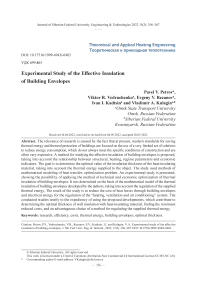Experimental study of the effective insulation of building envelopes
Автор: Petrov Pavel V., Vedruchenko Viktor R., Rezanov Evgeny V., Kadtsin Ivan I., Kulagin Vladimir A.
Журнал: Журнал Сибирского федерального университета. Серия: Техника и технологии @technologies-sfu
Рубрика: Исследования. Проектирование. Опыт эксплуатации
Статья в выпуске: 3 т.15, 2022 года.
Бесплатный доступ
The relevance of research is caused by the fact that at present, modern standards for saving thermal energy and thermal protection of buildings are focused on the use of a very limited set of solutions to reduce energy consumption, which do not always meet the specific conditions of construction and are often very expensive. A method for studying the effective insulation of building envelopes is proposed, taking into account the relationship between structural, heating, regime parameters and economic indicators. The goal is to determine the optimal value of the insulation thickness of the heat-insulating material, taking into account the thermal energy supplied to the object. The study used methods of mathematical modeling of heat transfer, optimization problem. An experimental study is presented, showing the possibility of applying the method of technical and economic optimization of thermal insulation of building envelopes. It was determined on the basis of the mathematical model of the thermal insulation of building envelopes developed by the authors, taking into account the regulation of the supplied thermal energy. The result of the study is to reduce the cost of heat losses through building envelopes and electrical energy for the regulation of the “heating, ventilation and air conditioning” system. The conducted studies testify to the expediency of using the proposed developments, which contribute to determining the optimal thickness of wall insulation with heat-insulating material, finding the minimum reduced costs, and an advantageous choice of a method for regulating the supplied thermal energy.
Research, efficiency, costs, thermal energy, building envelopes, optimal thickness
Короткий адрес: https://sciup.org/146282449
IDR: 146282449 | DOI: 10.17516/1999-494X-0403
Список литературы Experimental study of the effective insulation of building envelopes
- BS EN 15603:2008. Energy performance of buildings. Overall energy use and definition of energy ratings. Effective 2008-09-30. 66.
- Hong, T. et al. Data and analytics to inform energy retrofit of high performance buildings, Applied Energy. 2014. 126. 90-106.
- Crawley, D.B. et al. Contrasting the Capabilities of building energy performance simulation programs: report. United States Department of Energy: University of Strathclyde: University of Wisconsin. 2005. July. 59.
- Hoes, P. et al. User behavior in whole building simulation. Energy and Buildings. 2009. 41. 295-302.
- Fabi, V. et al. Description of occupant behaviour in building energy simulation: state of art and concepts for improvements. 12th Conference of International Building Performance Simulation Association, Sydney, 14-16 November. Proceedings of Building Simulation. 2011. 2882-2889.
- Alajmi, A. Energy audit of an educational building in a hot summer climate. Energy and Buildings. 2012. 47. 122-130.
- Lubina P., Nantka М.Internal heat gains in relation to the dynamics of buildings heat requirements, Architecture civil engineering environment. 2009. 1. 137-142.
- Maile T., Fischer., Bazjanac V. Building energy performance simulation tools. A life-cycle and interoperable perspective: report. Center for Integrated Facility Engineering. 2007. Dec. 43.


